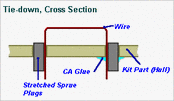1⁄35Modelling Tie-Downs
I have never had much success in modelling those tiny little tie-downs that to the distress of 1/35th scale AFV modellers show up on all AFVs no matter what nationality or time-period. I tried everything from forming them from stretched sprue and gluing directly to the model, to drilling pairs of tiny holes and inserting wire through, this method did have some promise and in fact I did base my new method on it, but they were not too strong and the resulting lateral play was most displeasing.
After looking through one of the "Panzers at Saumur" books it occurred to me that the typical German WW2 tie-down consisted of a loop of wire that was wound between two screws, with these screws being directly screwed into the AFVs' armour plate (in this case a Jagdpanzer IV), with the screw's head sitting a few millimetres proud of the surface. That's all fine and dandy for those who like models of German WW2 subjects, but what about other types? These look very similar to those on the M4 Sherman, (from what I can tell at least), however my method can be easily modified to make different styles of tie-downs that inherit the strengths and in-scaleness of the method; but first my method for the "typical" German WW2 tie-down (in 1/35th scale).
The diagram on the right is a big-scale cross section of what one of my model tie-downs will look like. Here is how I do it:
Drill pairs of small holes along the line that the tie-downs will sit. I find it more efficient to use a template, a small section of thin sheet styrene with two holes drilled through. This I then position on the model as a guide for drilling. Also it is best to mark a line on the model in pencil as well as this template, they should match up and no errors will be made. I use a no. 72 drill bit which is quite small, in a pin-vice. If you slip up and drill a hole out of alignment, simply jam in some stretched sprue, add a drop of liquid cement, let dry, and then have another go.
Loop some very thin wire, I use the copper wire unwound from those old Tamiya motorised tank kits, insert this into the holes drilled as per Step 1. Check your references as to how much of a loop is to be left.
Take sections of fine stretched sprue and jam them into the holes, thus trapping and fixing the wire loop into place.
Add a small drop of CA ("Super") glue from within the model's hull. this will keep evidence of gluing hidden (in the model) and fix the wire and sprue in place forever.
Finally, trip the tops of the stretched sprue to the height needed and if you are feeling really fancy, scribe in some slots for the screwdriver! Remember to check your reference photographs for these last two points.










